Ottawa winters are wet and cold. As you may already know, those kind of conditions could wreak havoc on your roof if it hasn’t been properly prepped. With winter just a few months away, it is time to start thinking about those long snowy months and how you can do things today that keep your roof safe throughout the winter season.
Doing the necessary preparations now means you will have a little less stress throughout the holidays. Besides, no one wants to deal with leaking and water damage in the winter, especially when you are entertaining and enjoying all the festivities.
THAT IS WHY WE CAME UP WITH A FEW TIPS ON HOW TO PREPARE YOUR ROOF FOR WINTER.
Let’s have a look.
INSPECT AND CLEAN OUT EAVESTROUGHS
Gutters, otherwise known as eavestroughs, might not seem very important, but they are vital to the health of your entire house. Because of that, you need to maintain them.
Gutters get clogged when debris accumulates. Fall is one of the worse times for debris to gather in unprotected eavestroughs, especially when your house is surrounded by trees. Unfortunately, when leaves, twigs, and other debris gets stuck in the gutter and water pools, gutters cannot perform their main purpose of leading water and snow away from your home.
Flooded gutters and downspouts will eventually lead to overflow—and that means potential damages to fascia. Furthermore, all the rainwater cascading down from an overflowing gutter will collect around the foundation of your home. In the wintertime, congested eavestroughs increase the chance of ice damming.
TRIM TREES AND SHRUBS AROUND YOUR HOME
Having trees around your house adds to the aesthetic value—until it cause issues with your roof. We’re not telling you to remove those trees. All you need to do is trim back the branches before wintertime. There are two advantages to trimming trees away from the roof: Less debris in your gutters and less of a change of branches getting stuck on the roof.
Tree limbs get heavier and twice as dangerous when it snows. Those branches might lean against the roof, scraping against the shingles. As snow starts to fall from the limbs to the roof, the weight on the roof and gutters will multiply. You can probably predict what will happen once that snow starts to melt.
Also, trees are home to pests. Squirrels, for example, will use tree branches to get onto the roof of your house. From there, they may be able to find a place where they can get into the internal structure of your home or the attic.
So trim the trees and tall bushes around your house to keep rodents out and to keep debris off the roof.
EXAMINE SHINGLES AND OTHER ROOFING MATERIALS
Shingles aren’t meant to last forever, but if you do routine maintenance, you ensure that it will last for many years. Loosened or missing shingles both pose a threat to your roof, particularly during the winter. Damaged shingles need to be replaced immediately. Otherwise, you could face leaking, mold growth, and dry rot.
If you don’t have shingles but some other roofing material, the same rule applies. Make sure there are no cracks or holes. Patch anything up that needs to be addressed immediately.
DOUBLE CHECK FLASHING
Flashing—one of the least understood parts of a roof for homeowners. Flashing might not look like much, but if you didn’t have it, you would have far more water damage. Flashing is usually made of aluminum or galvanized steel and functions as a protective layer directing moisture away from vulnerable sections of the roof, like seams, by shuttling it towards the gutters.
You will usually find flashing around intersections and joints, like the edges around vents, chimneys, or skylights.
Throughout the year, wind, rain, freezing temperatures, and debris can snag against flashing. It’s common to find flashing that has torn, corroded, loosened, or even lifted away from the underlay. When that happens, a clear path to the internal structure of the roof is opened up.
If you want to prevent water damage from the winter’s freeze-thaw cycle, then get your flashing inspected.
GET A ROOF INSPECTION
A roof inspection is for more than uncovering problems. It’s to gauge how many more years your roof will protect your home. The inspector studies the roof from every angle and even considers how long it takes for water to dry. Inspectors get up on the roof, walking around, seeking out weakened spots that could mean leaking or dry rot. If the roof isn’t safe, the inspector might use binoculars.
Some common roofing issues that roof inspectors find include:
- Sagging near ridges and rafters
- Missing roofing materials
- Loose or broken shingles and flashing
- Granules from shingles in the gutters
- Improper installation of flashing and also air conditioner units
- Rusted metal
- Damaged vent pipes
- Clogged drains
- Dry rot in corners and around dormers and chimneys
- Water pooling
- And more
Even if you can do most of the repairs yourself, getting a roof inspection is one of the best things you can do for your roof throughout the year. A roof inspector is going to have more experience spotting problems, so you can discover any issues much more quickly and prevent damage from occurring.
GET YOUR ROOF WINTERIZED TODAY
Wintertime in Ontario is cold and wet. In other words, it is the time when your roof is in the most danger. Inspecting your roof and doing some routine maintenance is essential. Keep your roof in top shape—it will save you from future stress.
You don’t have to do the inspection and maintenance alone. Enlist a professional roofer for assistance. Get in touch with us with any questions or concerns. We’ve got your back.




0 Comments